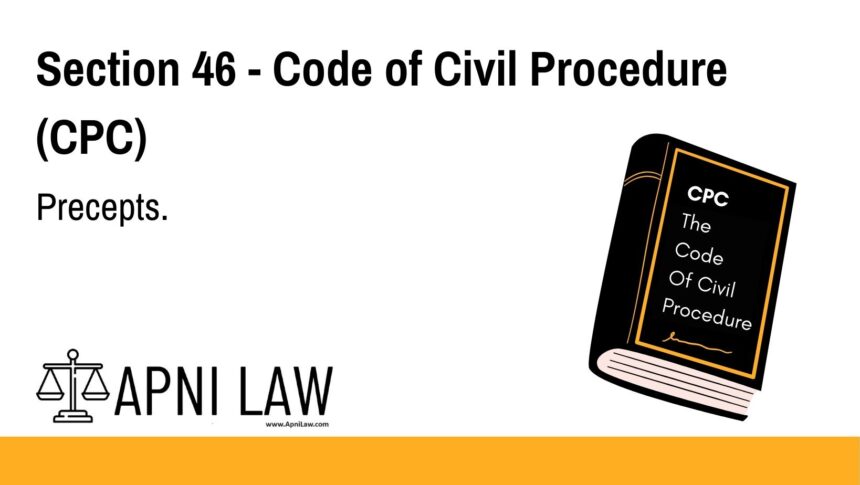Code
CPC(1) Upon the application of the decree-holder the Court which passed the decree may.
whenever it thinks fit, issue a precept to any other Court which would be competent to execute such
decree to attach any property belonging to the judgment-debtor and specified in the precept.(2) The Court to which a precept is sent shall proceed to attach the property in the manner prescribed
in regard to the attachment of property in execution of a decree:Provided that no attachment under a precept shall continue for more than two months unless the
period of attachment is extended by an order of the Court which passed the decree or unless before the
determination of such attachment the decree has been transferred to the Court by which the attachment
has been made and the decree-holder has applied for an order for the sale of such property.
Great 👍 Let’s now prepare the SEO-optimized structured article for Section 46 CPC – Precepts in the ApniLaw style.
Section 46 CPC: Precepts
Code
Section 46 – Code of Civil Procedure, 1908
(1) Upon the application of the decree-holder, the Court which passed the decree may, whenever it thinks fit, issue a precept to any other Court which would be competent to execute such decree to attach any property belonging to the judgment-debtor and specified in the precept.
(2) The Court to which a precept is sent shall proceed to attach the property in the manner prescribed in regard to the attachment of property in execution of a decree:
Provided that no attachment under a precept shall continue for more than two months unless the period of attachment is extended by an order of the Court which passed the decree or unless before the determination of such attachment the decree has been transferred to the Court by which the attachment has been made and the decree-holder has applied for an order for the sale of such property.
📖 Source: Section 46 CPC – Precepts (ApniLaw)
Explanation
Section 46 CPC introduces the concept of a precept.
- A precept is an order issued by the Court that passed the decree, directing another competent Court to attach property of the judgment-debtor.
- The purpose is to secure the property of the judgment-debtor before it can be alienated or transferred to frustrate execution.
- The period of attachment under a precept is limited to two months, unless:
- Extended by the decree-passing Court, or
- The decree is formally transferred to the Court where attachment is made, and the decree-holder applies for sale of property.
This section is essentially a preventive measure to protect the decree-holder’s interests.
Illustrations
- Example 1:
A decree-holder in Delhi fears that the judgment-debtor is about to dispose of property in Jaipur. The Delhi Court issues a precept to the Jaipur Court to attach the property. - Example 2:
A decree-holder obtains a money decree. To prevent the judgment-debtor from selling his land before execution, the Court issues a precept attaching the land for two months. - Example 3:
If during the two-month attachment, the decree is transferred to the attaching Court and an application for sale is filed, the attachment continues until execution is completed.
Common Questions and Answers
1. What is a precept under CPC?
A precept is a direction issued by a Court that passed a decree to another competent Court, ordering attachment of property of the judgment-debtor.
2. How long does an attachment under a precept last?
It lasts for two months, unless extended by the decree-passing Court or converted into a full execution proceeding.
3. Who can issue a precept?
Only the Court which passed the decree can issue a precept under Section 46 CPC.
4. Why is Section 46 CPC important?
It ensures that judgment-debtors do not defeat execution by transferring or hiding property before a decree is executed.
5. What happens after the two-month period expires?
If not extended or followed by transfer and sale proceedings, the attachment lapses automatically.
Conclusion
Section 46 CPC acts as a safeguard for decree-holders by allowing Courts to issue precepts for temporary attachment of property. This prevents judgment-debtors from frustrating execution proceedings by alienating assets.
It strikes a balance by imposing a two-month limit, while also permitting continuation if execution is properly transferred.
👉 Read more: Section 46 CPC – Precepts (ApniLaw)








